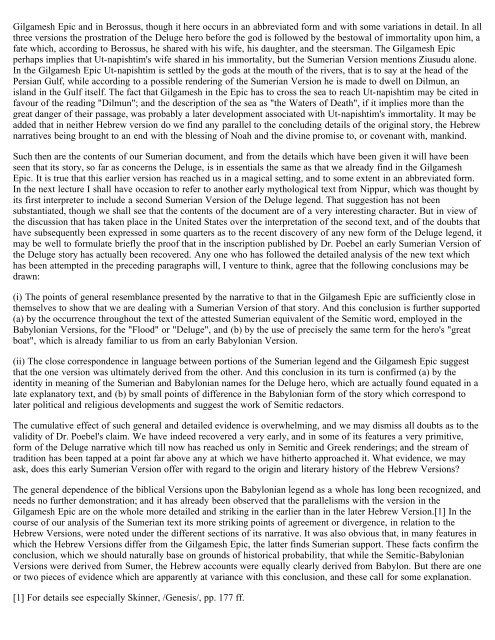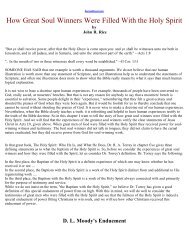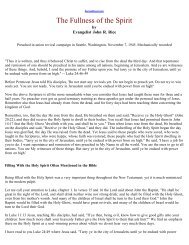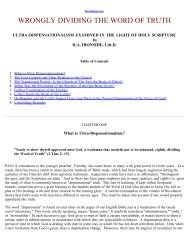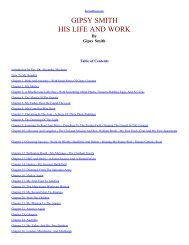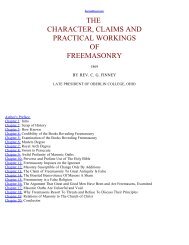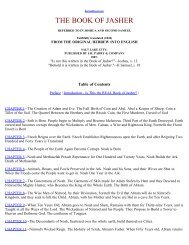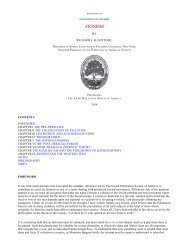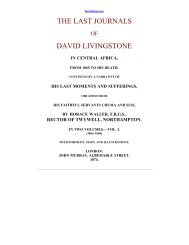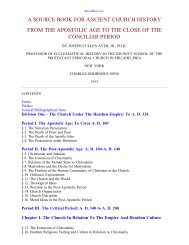Legends of Babylon and Egypt in Relation to Hebrew Tradition.pdf
Legends of Babylon and Egypt in Relation to Hebrew Tradition.pdf
Legends of Babylon and Egypt in Relation to Hebrew Tradition.pdf
Create successful ePaper yourself
Turn your PDF publications into a flip-book with our unique Google optimized e-Paper software.
Gilgamesh Epic <strong>and</strong> <strong>in</strong> Berossus, though it here occurs <strong>in</strong> an abbreviated form <strong>and</strong> with some variations <strong>in</strong> detail. In all<br />
three versions the prostration <strong>of</strong> the Deluge hero before the god is followed by the bes<strong>to</strong>wal <strong>of</strong> immortality upon him, a<br />
fate which, accord<strong>in</strong>g <strong>to</strong> Berossus, he shared with his wife, his daughter, <strong>and</strong> the steersman. The Gilgamesh Epic<br />
perhaps implies that Ut-napishtim's wife shared <strong>in</strong> his immortality, but the Sumerian Version mentions Ziusudu alone.<br />
In the Gilgamesh Epic Ut-napishtim is settled by the gods at the mouth <strong>of</strong> the rivers, that is <strong>to</strong> say at the head <strong>of</strong> the<br />
Persian Gulf, while accord<strong>in</strong>g <strong>to</strong> a possible render<strong>in</strong>g <strong>of</strong> the Sumerian Version he is made <strong>to</strong> dwell on Dilmun, an<br />
isl<strong>and</strong> <strong>in</strong> the Gulf itself. The fact that Gilgamesh <strong>in</strong> the Epic has <strong>to</strong> cross the sea <strong>to</strong> reach Ut-napishtim may be cited <strong>in</strong><br />
favour <strong>of</strong> the read<strong>in</strong>g "Dilmun"; <strong>and</strong> the description <strong>of</strong> the sea as "the Waters <strong>of</strong> Death", if it implies more than the<br />
great danger <strong>of</strong> their passage, was probably a later development associated with Ut-napishtim's immortality. It may be<br />
added that <strong>in</strong> neither <strong>Hebrew</strong> version do we f<strong>in</strong>d any parallel <strong>to</strong> the conclud<strong>in</strong>g details <strong>of</strong> the orig<strong>in</strong>al s<strong>to</strong>ry, the <strong>Hebrew</strong><br />
narratives be<strong>in</strong>g brought <strong>to</strong> an end with the bless<strong>in</strong>g <strong>of</strong> Noah <strong>and</strong> the div<strong>in</strong>e promise <strong>to</strong>, or covenant with, mank<strong>in</strong>d.<br />
Such then are the contents <strong>of</strong> our Sumerian document, <strong>and</strong> from the details which have been given it will have been<br />
seen that its s<strong>to</strong>ry, so far as concerns the Deluge, is <strong>in</strong> essentials the same as that we already f<strong>in</strong>d <strong>in</strong> the Gilgamesh<br />
Epic. It is true that this earlier version has reached us <strong>in</strong> a magical sett<strong>in</strong>g, <strong>and</strong> <strong>to</strong> some extent <strong>in</strong> an abbreviated form.<br />
In the next lecture I shall have occasion <strong>to</strong> refer <strong>to</strong> another early mythological text from Nippur, which was thought by<br />
its first <strong>in</strong>terpreter <strong>to</strong> <strong>in</strong>clude a second Sumerian Version <strong>of</strong> the Deluge legend. That suggestion has not been<br />
substantiated, though we shall see that the contents <strong>of</strong> the document are <strong>of</strong> a very <strong>in</strong>terest<strong>in</strong>g character. But <strong>in</strong> view <strong>of</strong><br />
the discussion that has taken place <strong>in</strong> the United States over the <strong>in</strong>terpretation <strong>of</strong> the second text, <strong>and</strong> <strong>of</strong> the doubts that<br />
have subsequently been expressed <strong>in</strong> some quarters as <strong>to</strong> the recent discovery <strong>of</strong> any new form <strong>of</strong> the Deluge legend, it<br />
may be well <strong>to</strong> formulate briefly the pro<strong>of</strong> that <strong>in</strong> the <strong>in</strong>scription published by Dr. Poebel an early Sumerian Version <strong>of</strong><br />
the Deluge s<strong>to</strong>ry has actually been recovered. Any one who has followed the detailed analysis <strong>of</strong> the new text which<br />
has been attempted <strong>in</strong> the preced<strong>in</strong>g paragraphs will, I venture <strong>to</strong> th<strong>in</strong>k, agree that the follow<strong>in</strong>g conclusions may be<br />
drawn:<br />
(i) The po<strong>in</strong>ts <strong>of</strong> general resemblance presented by the narrative <strong>to</strong> that <strong>in</strong> the Gilgamesh Epic are sufficiently close <strong>in</strong><br />
themselves <strong>to</strong> show that we are deal<strong>in</strong>g with a Sumerian Version <strong>of</strong> that s<strong>to</strong>ry. And this conclusion is further supported<br />
(a) by the occurrence throughout the text <strong>of</strong> the attested Sumerian equivalent <strong>of</strong> the Semitic word, employed <strong>in</strong> the<br />
<strong>Babylon</strong>ian Versions, for the "Flood" or "Deluge", <strong>and</strong> (b) by the use <strong>of</strong> precisely the same term for the hero's "great<br />
boat", which is already familiar <strong>to</strong> us from an early <strong>Babylon</strong>ian Version.<br />
(ii) The close correspondence <strong>in</strong> language between portions <strong>of</strong> the Sumerian legend <strong>and</strong> the Gilgamesh Epic suggest<br />
that the one version was ultimately derived from the other. And this conclusion <strong>in</strong> its turn is confirmed (a) by the<br />
identity <strong>in</strong> mean<strong>in</strong>g <strong>of</strong> the Sumerian <strong>and</strong> <strong>Babylon</strong>ian names for the Deluge hero, which are actually found equated <strong>in</strong> a<br />
late explana<strong>to</strong>ry text, <strong>and</strong> (b) by small po<strong>in</strong>ts <strong>of</strong> difference <strong>in</strong> the <strong>Babylon</strong>ian form <strong>of</strong> the s<strong>to</strong>ry which correspond <strong>to</strong><br />
later political <strong>and</strong> religious developments <strong>and</strong> suggest the work <strong>of</strong> Semitic redac<strong>to</strong>rs.<br />
The cumulative effect <strong>of</strong> such general <strong>and</strong> detailed evidence is overwhelm<strong>in</strong>g, <strong>and</strong> we may dismiss all doubts as <strong>to</strong> the<br />
validity <strong>of</strong> Dr. Poebel's claim. We have <strong>in</strong>deed recovered a very early, <strong>and</strong> <strong>in</strong> some <strong>of</strong> its features a very primitive,<br />
form <strong>of</strong> the Deluge narrative which till now has reached us only <strong>in</strong> Semitic <strong>and</strong> Greek render<strong>in</strong>gs; <strong>and</strong> the stream <strong>of</strong><br />
tradition has been tapped at a po<strong>in</strong>t far above any at which we have hither<strong>to</strong> approached it. What evidence, we may<br />
ask, does this early Sumerian Version <strong>of</strong>fer with regard <strong>to</strong> the orig<strong>in</strong> <strong>and</strong> literary his<strong>to</strong>ry <strong>of</strong> the <strong>Hebrew</strong> Versions?<br />
The general dependence <strong>of</strong> the biblical Versions upon the <strong>Babylon</strong>ian legend as a whole has long been recognized, <strong>and</strong><br />
needs no further demonstration; <strong>and</strong> it has already been observed that the parallelisms with the version <strong>in</strong> the<br />
Gilgamesh Epic are on the whole more detailed <strong>and</strong> strik<strong>in</strong>g <strong>in</strong> the earlier than <strong>in</strong> the later <strong>Hebrew</strong> Version.[1] In the<br />
course <strong>of</strong> our analysis <strong>of</strong> the Sumerian text its more strik<strong>in</strong>g po<strong>in</strong>ts <strong>of</strong> agreement or divergence, <strong>in</strong> relation <strong>to</strong> the<br />
<strong>Hebrew</strong> Versions, were noted under the different sections <strong>of</strong> its narrative. It was also obvious that, <strong>in</strong> many features <strong>in</strong><br />
which the <strong>Hebrew</strong> Versions differ from the Gilgamesh Epic, the latter f<strong>in</strong>ds Sumerian support. These facts confirm the<br />
conclusion, which we should naturally base on grounds <strong>of</strong> his<strong>to</strong>rical probability, that while the Semitic-<strong>Babylon</strong>ian<br />
Versions were derived from Sumer, the <strong>Hebrew</strong> accounts were equally clearly derived from <strong>Babylon</strong>. But there are one<br />
or two pieces <strong>of</strong> evidence which are apparently at variance with this conclusion, <strong>and</strong> these call for some explanation.<br />
[1] For details see especially Sk<strong>in</strong>ner, /Genesis/, pp. 177 ff.


